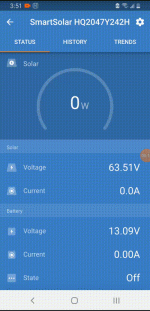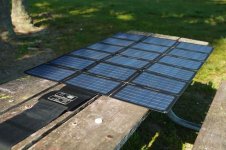AFAIK the victron, if an MPPT, would be designed to source power from the panel itself, with it's electronics designed not to deal with a simple voltage source, but the variable resistance, voltage, and current of the panel itself. You'd have to check its' manual if it has a simple voltage-input mode and use that if you're not running it from a panel directly.
Otherwise I think you are probably best off either getting a separate panel for the victron to run from, or skip using the victron entirely and use a normal DC-DC that will run off your ebike battery and give you the voltage and current-limited output that you are after. Then leave your bike battery connected to the charger output of the panel so it can stay topped off while you're doing this.
This DC-DC will have to be a charger in it's own right, that has an output compatible with your LiFePo4 pack's charge input (the right full-charge voltage, and CC/CV output type that limits current the same way a charger or LED PSU does, rather than the way most DC/DC's do which is to shutdown once past their current limit...but it *has* to be current limited to a safe limit for the input of your LFP pack, *and* it can't use more power (Watts) than the output of your battery can supply.. W is V x A, so whatever the total output at max charging current the LFP pack would ever draw is times the volts it charges at, is the watts it supplies...the watts it takes out of your other pack will be higher than this, you can use 1.25x that for a good guesstimate (it could be less, or more, but that's a usually-safe number). Then divide that watt number by the ebike battery volts, and that gives you the ebiek battery output amps it has to supply to do the job.
It's not as efficient as running hte victron right off the panel, but it means you won't be potentially destroying things by opening them up and connecting / disconnecting things, or potentially overloading outputs of the built in electronics by drawing more current than they can supply or putting a kind of load on htem they can't handle (weren't designed for), etc.
It's no less efficient than trying to use a DC-DC to get the 12v output up to 24v and then running the victron off of that, and it's safer, since the battery can handle continuous or peak current of probably more than the panel's electronics can.





